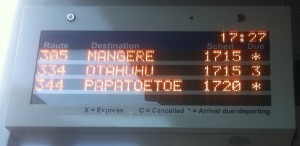99% punctuality
There are new bus prediction boards at some stops (this one is in Newmarket), which show the scheduled time and the estimated time to arrival.
The most obvious benefit of these is that you can verify how the prediction system is unreasonably optimistic for buses still a long way off and then gets more realistic as they approach. They also make clear how detached from reality the official punctuality statistics are.
Our only source of punctuality data for the 99%+ figures that keep getting reported is the companies themselves, and the definition of punctuality (the bus is no more than 5 minutes late at the start of the route and doesn’t get abducted by aliens on the way) is so useless that (pace Brian Rudman and others) the companies would hardly need to lie about it.
Given that Auckland Transport thinks it knows where the buses are, it wouldn’t be too hard to switch to a meaningful definition: something like “proportion of specified timetable points where the bus is no more than 5 minutes late or 1 minute early”. The figures would be lower, but that’s ok. It’s hard to run buses to a tight schedule through a congested central city, and some of them will be late. But you’re not going to get on-time arrival at bus stops by monitoring on-time departure at the start of the route.
I’d also note that the new bus prediction boards have missed a big opportunity. According to the sign, the asterisk indicates that a bus is about to arrive. Since the sign displays the scheduled time, they could have used the asterisk or some other symbol to indicate that the system didn’t currently have reliably location information for that bus. It’s obvious that sometimes the system is using actual locations and sometimes it’s just relying on the timetable, and telling us what is going on would make it measurably less annoying when the time counts down to zero and no bus appears.
Thomas Lumley (@tslumley) is Professor of Biostatistics at the University of Auckland. His research interests include semiparametric models, survey sampling, statistical computing, foundations of statistics, and whatever methodological problems his medical collaborators come up with. He also blogs at Biased and Inefficient See all posts by Thomas Lumley »

When checking bus arrival times in Christchurch the system seems to use some “average” travel time that totally ignores traffic. Of course deviations from the predicted time can increase quite a bit at peak times (when most of us actually catch a bus), creating a Windows File Copy Dialog situation.
12 years ago
or when the bus was predicted to arrive did not arrive and then vanishes from the Board.
Sometimes never to be replaced even by the next scheduled bus
Watch the north bound 881 at 5 pm onwards for this wonderful occurrence.
12 years ago
Not that long ago when I was working on Auckland public transport issues for a while the measure of on time performance was % arriving +/- 30 minutes of scheduled time.
I suspect the companies figure out what performance level they want and then come up with a measure that will deliver it.
12 years ago